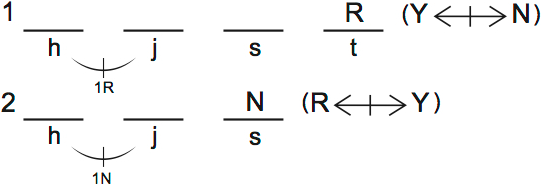This is an explanation of the second logic game from Section III of LSAT Preptest 29, the October 1999 LSAT.
Two mannequins (1, 2) will be dressed for display. There is a total of ten clothing articles. Each article is one of three colors: navy, red or yellow (N, R, Y). There are three jackets (J) – one in each color; three hats (H) – one in each color; three skirts (S) – one in each color and a red tie (T). You must determine the possible clothing combinations by using the rules.
Game Setup
This is a grouping game. Many students struggle to make a good diagram. But once you do get the diagram, it’s a fairly easy game.
First, I’d like to clear up a common point of confusion. There is exactly one of each type of clothing. If one mannequin wears the red hat, the other mannequin can’t wear it.
Second, the most important thing on any game is how to set up the main diagram. That’s especially true on this game, but many students rush to start drawing rules without thinking about how to draw the rules. They get a bad diagram, and get questions wrong.
So read over everything first, and then decide how to set things up.
The first question often gives you a clue. Notice that in the answers, the mannequins are vertical, and their clothing is horizontal.
…that’s hard to describe, so I’ll just show you a picture.

There are our two mannequins, and the clothing they wear. Number 1 is on top, with the tie.
I’m going to start with rule 2. There’s very little you can do with rule 1 right away. It’s not very useful to draw rules in isolation.
Often you can combine rules such as the first rule later, once you’ve drawn the other rules (in this game, you can). There’s no need to do the rules in order.
So, rule two says that the hat and the jacket are never the same color. You need something on your diagram to remind you, or you might forget.

I like an arc underneath h and j, with a line through it (see the diagram).
If you draw the rules directly on your diagram, it’s very hard to forget the rule. Students frequently forget their rules – you need a mechanism to prevent this.
Draw the last two rules first
The last two rules are easy to draw. That alone is good reason to draw them before drawing the first rule.
Mannequin 2 wears the Navy Skirt.
Mannequin 1 wears a red tie because the tie only comes in one color…red.

Be specific. What colors can’t the mannequins wear?
Now we can do something with the first rule. The mannequins can’t wear all three colors. Mannequin 1 is already wearing R, so this means he can’t wear Y and N are the same time.
Mannequin 2 is already wearing N, so this means mannequin 2 can’t wear Y and R at the same time.
It’s best to draw these deductions directly on the diagram, too.
The double arrows with a line in the middle mean that the mannequins can wear one but not both of the listed colors.

The diagram instantly shows all the rules
Now we’re getting somewhere. This tiny little diagram shows all the rules.
Being slow to remember rules is the biggest problem most people have with logic games. This diagram lets you see all the rules at once, once you understand the symbols.
It’s still useful to keep the rules in mind of course. You will work through the game faster if you commit to memory these two facts:
- The hat and jacket are different.
- No mannequin can wear all three colors.
We can make one more deduction. What colors can the hat and jacket be? They have to be different colors – but on mannequin 1, for example, they can’t be Y and N. Then the mannequin would wear all three colors. So either the hat or jacket is R, and the other is Y or N.
For Mannequin 2, either the hat and jacket will be N, and the other will be R/Y, for the same reason.

So here is the final diagram. It has every rule, plus an important deduction. If you draw this diagram, and you understand what it means, then the game is easy.
If you’re not sure what it all means, then don’t go on to the questions yet. Reread the rules, and reread my setup. Try drawing the diagram yourself.
These symbols are very powerful for solving logic games, but learning them is like learning a new language. It takes a bit of effort, but you’ll be amazed at what you can do with it once you learn it. And it’s not as hard as you’d think.


Hey there… how long should this game take?
As I re-drill games it is helpful to have a target time to work towards. Maybe this is something you would consider adding in the future for each game? Just a suggestion.